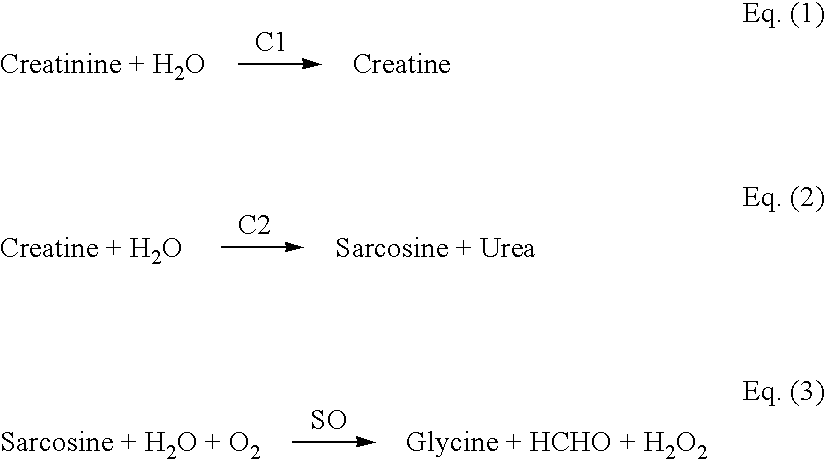Biosensor and method
a biosensor and method technology, applied in the field of biosensors, can solve the problems of lack of specificity, low usefulness of potentiometric methods, and time-consuming to perform the analytical method
- Summary
- Abstract
- Description
- Claims
- Application Information
AI Technical Summary
Benefits of technology
Problems solved by technology
Method used
Image
Examples
example 2
Demonstration of Precision of Sensors
[0116] The precision of the sensors of the present invention was investigated at the creatinine level of 2 mg / dL in a blood sample. The creatinine level was confirmed by measurement using the Nova Stat Profile M, Nova Biomedical Co., Waltham, Mass. Table 2 shows the current response in nanoamps of a blood sample spiked with 2 mg / dL of creatinine using various sensors of the present invention.
3TABLE 2 Precision Study Current Run No. (nA) 1 55 2 55 3 55 4 61 5 55 6 55 7 59 8 53 9 59 10 56 11 56 12 59 13 60 14 62 15 62 16 62 17 60 18 57 19 60 20 62 21 59 Average 58.2 CV, % 5.0
[0117] Twenty-one (21) sensor strips from the same batch were tested and a coefficient of variation (CV) was found to be 5.0%.
example 3
Demonstration of Interference Free Feature
[0118] The most important challenge for the measurement of creatinine is the interference from creatine, as it always co-exists in the sample along with creatinine. The unique design of the present invention makes it possible to eliminate the interference from creatine. This is achieved by subtracting the response obtained at W1 from the response obtained at W2, and is represented by the following equation:
I=Iw.sub.2-Iw.sub.1 Eq.(7)
[0119] where
[0120] Iw.sub.2 is the current at W2 (second working electrode)
[0121] Iw.sub.1 is the current at W1 (first working electrode)
[0122] I is the difference between W2 and W1 and represents the current due to oxidation of the mediator of its reduced form, which is proportional to the creatinine concentration in the sample
[0123] Because W1 and W2 have the same surface area, the potential interference present in the sample fluid should give relatively identical signals from each working electrode.
[0124] This ...
example 4
Demonstration of Minimum Sample Volume Feature
[0127] The unique design of the present invention enables the measurement of sample sizes smaller than have heretofore been possible. Blood samples are applied to the sensors and the samples travel along the sample fluid channel to the threshold of the vent hole. In order to test the volume effect on sensor response, different blood sample volumes were applied to the sensors. Table 4 shows the current response versus volume size.
5TABLE 4 Response to Sample Volume Volume (uL) Current (nA) 1.5 60 2 59 3 58 4 55 5 55
[0128] The resulting current signals were plotted against volume and is shown in FIG. 10. From the data and the graphical representation, sensors of the present invention for the sizes disclosed earlier show no dependence of the response on the sample volume if the volume is above 1.5 microliters.
Glucose and Cholesterol Sensors
Preparation of Reagents
[0129] Reagents for both Glucose and Cholesterol Sensors comprise the reduced fo...
PUM
| Property | Measurement | Unit |
|---|---|---|
| Time | aaaaa | aaaaa |
| Temperature | aaaaa | aaaaa |
| Current | aaaaa | aaaaa |
Abstract
Description
Claims
Application Information
 Login to View More
Login to View More - R&D
- Intellectual Property
- Life Sciences
- Materials
- Tech Scout
- Unparalleled Data Quality
- Higher Quality Content
- 60% Fewer Hallucinations
Browse by: Latest US Patents, China's latest patents, Technical Efficacy Thesaurus, Application Domain, Technology Topic, Popular Technical Reports.
© 2025 PatSnap. All rights reserved.Legal|Privacy policy|Modern Slavery Act Transparency Statement|Sitemap|About US| Contact US: help@patsnap.com



